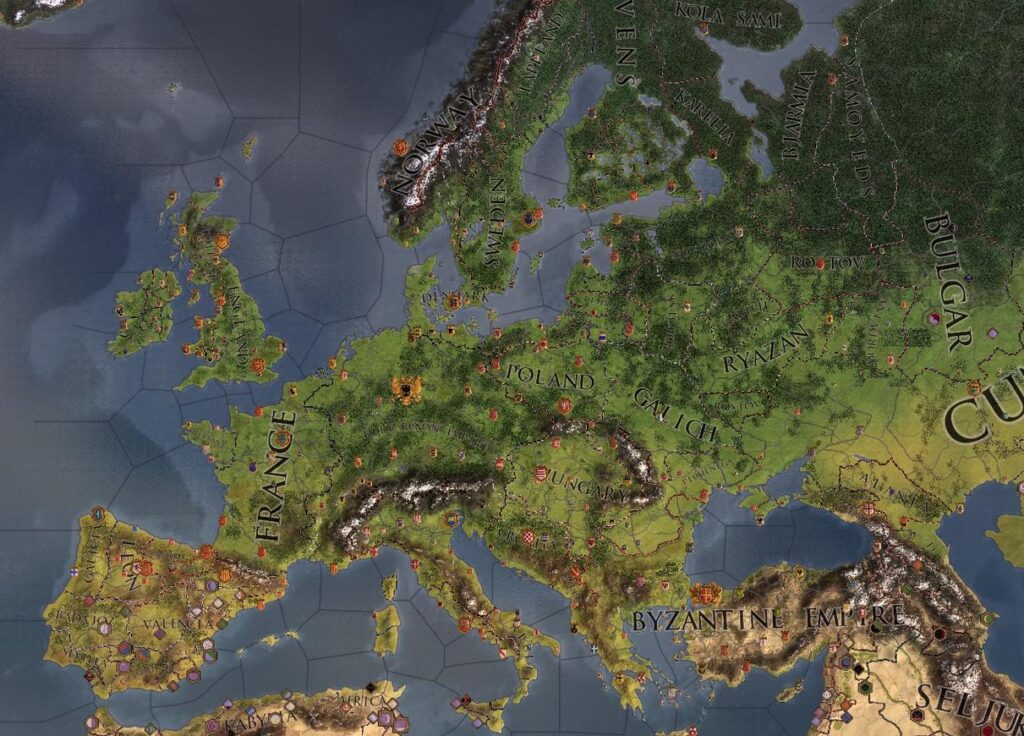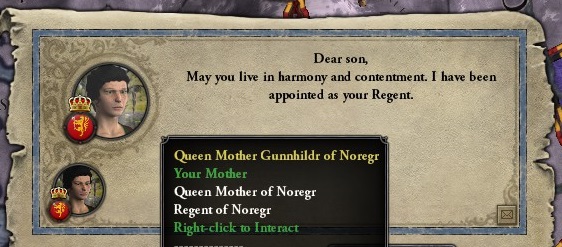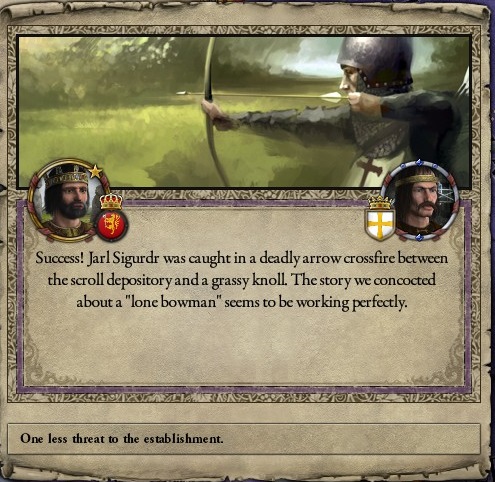Markus Mindrebø (University of Stavanger)
Paradox Interactive’s Crusader Kings series of games provides excellent opportunities to explore and visualise the development and breakdown of medieval aristocratic relationships. Utilising its mechanics of opinion values and character traits, we can gain an invaluable tool for studying the networks of the Middle Ages.

This paper is first and foremost intended to feature a small example from an article I recently published in the Journal of Historical Network Research, establishing a framework for using Crusader Kings II as a tool for analysing networks in medieval sources. Here, I simply wish to draw out a brief example of how the game can be used, and will refer the audience to the full article for further depth.
In terms of network breakdown, the most important part of the simulation experiments were centred around taking the role of the child Haraldr gráfeldr, who in saga histories of Norway assumes the kingship upon the violent death of his (despite being a Christian in a pagan land) surprisingly popular uncle Hákon. The game repeatedly closely replicated many events of the saga narrative, including the assumption of some form of regency by Haraldr’s infamous mother Gunnhildr.

As in the saga narratives, despite having taken the country by force, my characters were not immediately unpopular, but were able to consolidate control and establish cordial relations with most regional Norwegian rulers. It was from here on that I attempted to replicate their actions across a series of simulation runs to illustrate the successful Crusader Kings portrayal of relations breakdown: most importantly by acting in a tyrannical fashion and assassinating key rivals, first and foremost the jarl Sigurdr, whose son later comes back in the narrative to kill and usurp Haraldr.

This assassination, combined with other comparable actions including the killing of my characters’ kinsmen, always led to a gradual chipping away of non-player characters’ personal opinion of my ruler, which could be constantly tracked on the character screens, and led to an extreme when my character was labeled with the ‘Kinslayer’ trait (ultimately this culminated in my ruler’s defeat, as in the saga narratives).

This paper is just an attempt to recreate and showcase how a medieval narrative pattern is presented in Crusader Kings terms and numbers, but the ultimate goal with this project and the longer article this sample is drawn from, is to utilise the game simulation to accumulate data with which to return to the original source material, and examine it further.
By taking the format of the game and adapting it, working with the game code and modifying the parameters according to research needs, we can ultimately utilise not merely the game as is, but the structures and algorithms it was created with, for research purposes. Through this, the game can become a gold-mine for network-oriented historians.
Suggested reading
Mindrebø, Markus Eldegard (2024). Simulating medieval connections: Grand strategy games and social network analysis. Journal of Historical Network Research (JHNR), 10(1).

Really interesting! I love the idea of going back to the game and using it as a tool for research. How easy would you say this would be for historians that are not familiar with coding but would like to use this for their work? By the way, congratulations on your publication 😊
Thank you, Mariana! I am tempted to say it is actually shockingly easy, but it really depends on the type of material one would be working with. Some medieval sources and political narratives are already more integrated in the games than others. But as long as there is an acceptance that the game presentation will be rather dubious in many cases, it’s fair enough to dive straight in with no modification and just play around with the simulations and treat it as the wonderful heuristic tool it can be (although active modification would make the tool itself better in the long run). I was trying to go for a more strictly defined methodology when I did these experiments, but it’s not necessarily needed for all historical studies using the game.
Great! Fantastic!
Thank you for this, Markus. I’m really eager to read your latest paper. I just started a research group to create mods for scholarly purposes, and your work seems to be going in the same direction!
May I ask you about some of the more practical aspects of the experiment? I assume you fleshed them out in the paper, but if you could give me some spoilers I’d appreciate it!
Specifically:
1- One thing “vanilla” CK does really badly is letting us visualize the network as a whole. We’re mostly stuck with an individual point of view, watching things play along from a single node. How are you addressing/planning to address that? Do you plan to mod other visualization modes into the game? Or letting players experiment on the local level and subsquently exporting and analyzing data?
2- How are you handling/planning to handle publication (and specifically, publication of data)? In my modding taskforce, we decided to start with an open-source game created by an archaeologist, who kindly let us run wild with it. However, CK is proprietary. Doesn’t that pose a challenge in transparency and accessibility?
Thanks, Vinicius. The article used minimal modification (essentially only tweaking with the console rather than modifying file code), so that’s thus far only been a plan I’ve shoved into the future. For your first question, I completely agree with you about the visualisation problems inherent to the game. For my own research I have tended to focus on individual relationships and cause-and-effect schemes of network development rather than a full SNA study, but to go for the latter I think much more significant modification (as you suggest) would be needed – either internally or externally.
For the second question, it really all depends on what the studio would permit – as the alternative would of course be to build a game from scratch. I’ve been chatting with people at Paradox in the past and would love to pick up that thread again if I am to continue working on this, but currently it’s a bit dormant while I’ve been focusing on some other projects 🙂
Great to hear about the research group – what is the focus of what you’ve done so far?
Our first modding project (which we’ll start next month, after Leeds), will be on an adventure game about archaeology aimed at elementary schoolers (“Heritage Detective” by Amanda Pina). The main goal of this first exercise is to get the team familiarized with modding and coding – although I hope the resulting mods will be of use to Amanda, expanding the scope/usefulness of her game.
After that… we’ll see! But the mods will probably be related to mortality crises and circulation dynamics in Western Europe and the Mediterranean. I’m working on a broader collective research project on that theme (mostly studying the plague pandemic and environmental phenomena), and I plan to design mods to serve as outputs for the findings of the project – because, like you said, it’s way easier than designing a whole game from scratch!
Sounds fantastic; would be thrilled to see where it leads!